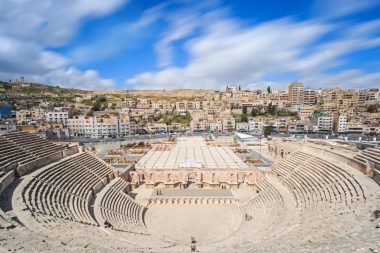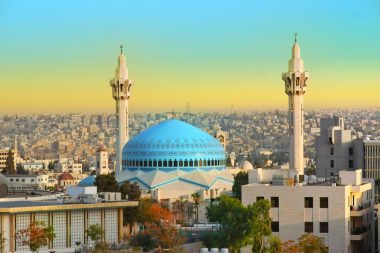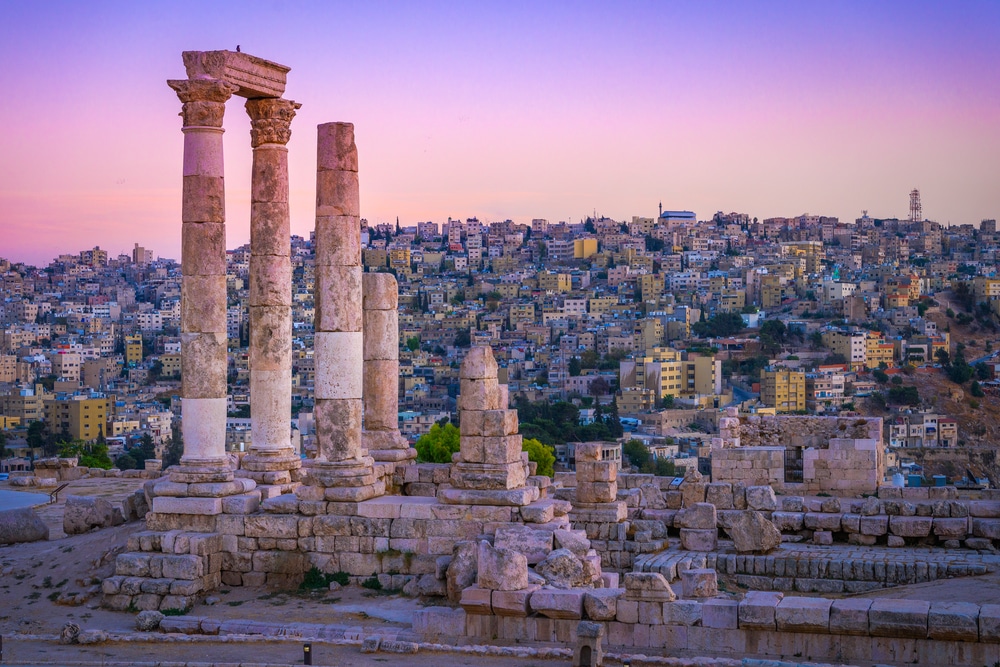At the intersection of historic caravan routes lies one of the most interesting metropolises in the Middle East on biblical ground: Amman. Jordan’s capital looks back on a long history of settlement. Rome was built on seven hills, but Amman has expanded over the centuries and now has 19 hills. The city is proud of its history, it presents itself as Arab and at the same time enlightened. If you stroll along the boulevards there with your eyes open, you will feel a touch of joie de vivre. And this in the immediate vicinity of Syria, where a civil war has been raging for a very long time, and of Israel, with which Jordan shares a largely pacified border.
Graceful minarets in a sea of white houses

“Jebels” is what the people of Amman call their nineteen hills, which are covered by a sea of white houses and from which the graceful minarets of the mosques rise here and there. The youngest scion of the Hashemite dynasty reigns here, and quite a few residents of Amman are proud of their royal family and see themselves as part of the ruling family. You will look in vain for architectural wonders in this city, because an earthquake in 1927 destroyed numerous historically significant testimonies of antiquity. What has remained is a decades-long requirement by the authorities: All houses must be clad with the sandstone typical of Jordan. In the meantime, many impressive villas have replaced the traditional houses made of clay.
“Philadelphia” – City of “Brotherly Love”
Without a doubt, the hill with the citadel is the heart of the old city. These fortresses were repeatedly rebuilt over time, destroyed in wars and then expanded. The citadel found its roots as early as the 2nd century AD. At that time, Amman was still part of the Roman Empire – legions were stationed here and the Roman governor ruled here with a heavy hand. Very often, this part, as a fixed point of the trade routes leading to Egypt, Syria or Mesopotamia, aroused the desires of the neighbors. Alexander the Great conquered the city, and it was occupied by Macedonians. Their king gave Amman the name “Philadelphia“, which can be translated as “brotherly love”. Trade flourished there, and the city was the center of the caliphate.
Collection basin for refugees from the neighbourhood
Two million people live in Amman today. This was also a gathering place of refugees from Palestine, Lebanon, Iraq and Syria. And so the capital of Jordan is not only one of the oldest but also one of the fastest growing metropolises in the world. If you want to understand the history of Amman, you should take a close look at the aforementioned citadel on Jebel el Qala’a, because it was both a religious and a military center. Among other things, the Temple of Hercules, which the Romans built between 162 and 166 AD, is worth seeing. Photogenic is the “Stone Hand”, which was once part of a 17-metre-high statue. The view of the Roman Theatre, which is characterised by fascinating acoustics and is still used for cultural events, is also impressive.
The winding streets of the old town

The King Hussein Bin Talal Mosque is the largest Islamic place of worship in the country. It was also built on one of Amman’s numerous hills, is unmissable with its majestic minarets and was equipped with golden ornaments, floors made of fine marble and valuable carpets. The State Mosque of Jordan also houses a museum and a library with historical testimonies. The culture of the Arab hemisphere shapes the image of this city. Especially that of the old town with its winding streets and impressive buildings. A visit to the traditional souk is a “must” during a stay in Amman. In the numerous first-class restaurants, the entire range of Middle Eastern dishes is presented to gourmets from all over the world. The old town also sees itself as a place of music, dance and art.
Luxury in Al Sweifieh and the scent of spices
If you have chosen Amman as the destination of a shopping tour, you may enjoy haggling with the traders in the bazaar. A little away from the busy Rainbow Street, at the highest part of the city, the visitor encounters the so-called “Gold Market”, where fine jewellery is always offered and where the prices are cheaper than in Europe. Many a tourist is surprised when he strolls through the Al Sweifieh district, because there he encounters luxury items of all kinds in fashion boutiques and modern shops. The city’s markets are a kind of counterpoint to the glamour of this posh neighborhood. Here, the scent of spices reigns, and haggling between traders and buyers is also part of everyday life there. One should not be afraid to follow the customs. However, according to Arab custom, respect dictates that only those who want to buy act.
The blue dome of the King Abdullah Mosque
A Bohemian-German architect erected a monument to himself in Amman. Jan Cejka built the King Abdullah Mosque between 1982 and 1989, which has become a landmark of the Jordanian capital with its gigantic blue dome. However, the most impressive view of the mosque is reserved for men only. They then sit with their hookahs at the windows in the Arab League Cafè and look down on the lively hustle and bustle in front of the mosque. Judaism, Christianity and Islam – three religions refer to the Old Testament. And here, in Jordan, the traditions have their origins. In Amman, too, the traces of faith are omnipresent.


